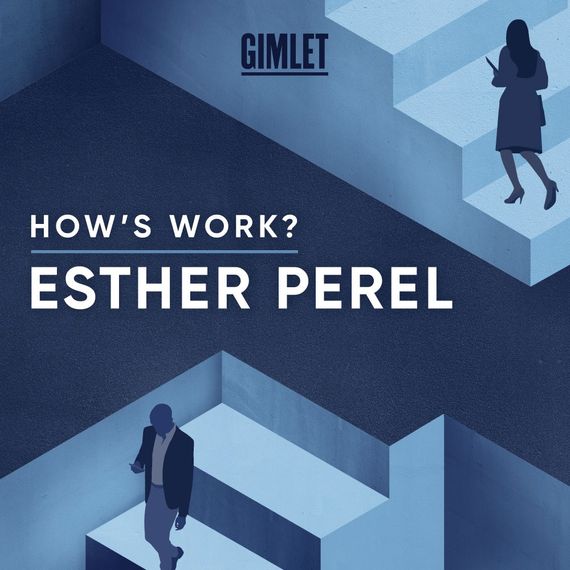
Listening to an episode of Esther Perel’s Where Should We Begin podcast is like peeking into a well, tipping over, and falling right in. It begins as a minor act of curiosity and ends with a major act of emotional complicity, a vertigo of finding yourself wrapped up in the drama of someone else’s life. But it’s more than voyeurism. As Perel and her production team like to note, listeners feel the way they do because they’re seeing themselves in that drama.
Let’s back up. For the unfamiliar, Where Should We Begin is a podcast that offers listeners a window into Perel’s couples therapy sessions. Perel, a famed Belgian cross-cultural psychologist and educator who has written numerous books and given countless talks on the subject of relationships and sexuality, conducts these sessions based on a structural conceit: couples who apply and get accepted are given only one session. There’s a functional purpose to the one-and-done format. The scarcity raises the stakes for the people going into them, incentivizing a need to get as much on the table as soon as they can. The result, when documented, is a concentrated capsule of human drama.
Produced with the podcast studio Magnificent Noise, each episode is designed around a session recording, edited down for public consumption and with the identities of the couples made anonymous. The episodes are sprinkled with narration by Perel, who dips in and out of the recording to give an assessment of the situation, explain what she’s trying to do in the moment, and sometimes wax philosophical. These interjections are central to Perel’s broader enterprise with the podcast. Above all, she sees it as a piece of education technology that contributes to a larger goal of, in her words, “de-pathologizing therapy” and bringing the practice into the public square.
Last November saw the launch of Perel’s second show, How’s Work?, which sees the therapist expand her efforts, both in terms of counseling and podcasting, into the arena of workplace relationships. (How’s Work, by the way, is released as a Spotify exclusive.) The expansion is reflective of a societal trend. “There’s a fascinating shift that’s happening where the world of emotions has entered the workplace,” she observed. “Vulnerability, transparency, trust, belonging, purpose, meaning, you name it — all those words are now part of the professional vocabulary.”
Vulture recently spoke to Perel and her producer, Jesse Baker, about their approach to producing the two deeply sensitive podcasts.
Step 1: Choosing the Couples, Individuals, or Subjects
Individuals or couples are selected for inclusion into the podcast in pretty much the same way they’d get into a therapy session with Perel. Which is to say, it begins with an application. “If you hunt around, you can find the application online,” says Baker. Applicants start off by answering a series of basic biographical questions — age, gender, and so on — before going through questions meant to screen for more specific behavioral and psychological elements: spiritual beliefs, occupational situation, and mental health history, among others.
“The most question we’re trying to answer here is: Why do you want to come?,” says Perel. “What is it that brings you to do this? What is it that you expect from this work, for your life and your relationships? What are you prepared to do to achieve what you say you want?”
Once the entries are compiled, Baker goes over the submissions, assesses them based on a number of criteria, and chooses the applicants who will move on into the preinterview process. “It’s a strange experience,” she says. “I’m a news producer, not a therapist, so I tell them that but also let them know I’m not going to judge them — that this is a safe space.”
These preinterviews usually run for about 45 minutes to an hour. Couples are screened separately, so that each partner won’t be influenced by each other’s answers. Unlike the application, these conversations are narratively oriented … and can get pretty emotional. “After we’re done with the hour, and [I’ve] been crying them over the phone, I’m like, ‘I really want to help you. I can’t help you, but I know who can,” said Baker.
The pre-interview phase can take a while, as the goal is to push the episodes towards new directions. “I probably go through ten or twelve couples for every one that we end up with,” says Baker. “I’m trying to get something different that we haven’t done. We’re halfway recording season four right now, and I’m still surprised that there are issues we’ve never had before.”
The popularity of Where Should We Begin has had some impact on the screening process, as applicants generally walk in with a firm grasp of what Perel’s counseling session involves and the fact they’re going to be recorded.
Both Perel and Baker observe that preinterviewing for How’s Work has turned out to be much harder compared to Where Should We Begin. “In the family, I think we expect a certain kind of emotional vulnerability,” says Perel. “We don’t necessarily think about relational matters in the context of work.”
Baker adds: “Asking people to talk about their sex lives is significantly easier than getting them to talk about their problematic co-worker. It’s like pulling teeth.”
Step 2: Taping a Session
For the people coming into the counseling session, the experience begins a one-page release form. “The language is pretty understandable,” says Baker. “But I always offer to go through what it means.”
During the actual session itself, everything — from the counseling to the narration tracking that happens afterward — is captured on-site in Perel’s New York office, not in a studio. Everybody in the room gets a lavalier microphone (i.e. the ones that can clip onto a collar), and a few shotgun microphones are placed throughout the room to capture Perel’s speech when she’s not moving around.
The underlying goal is to preserve the counseling experience as much as possible, which means finding ways to record without drawing too much attention to the recording process. “Esther loves to have people stand up and walk around the room,” Baker says. “We were a little scared about that at the beginning.” But the recording set-up works well, as the lavalier and shotgun mics are able to collectively accommodate for a variety of room situations.
Still, there’s always the possibility that the very presence of the mics might trigger self-consciousness on the part of the subjects. That potential hurdle is generally alleviated by Perel’s room management. “I have done taping for my entire career, between teaching couples therapy and being trained with videotape and one-way mirrors,” she says. “I’m used to being watched. And so I know how to set things up comfortably in the room — I tell them we’re all mic’d, that I’m not uncomfortable either, and then we all laugh.”
When the session begins, Baker and a recording engineer, Noriko Okabe, are sequestered to another office down the hall from Perel, where they listen in. “Once we shut the door, we don’t go back in,” Baker noted. A session, and the recording process, typically takes about three hours.
Step 3: Finding the Shape of the Episode
Once the session is over, Perel regroups with the production team to go over the hours of tape in search of the big, resonating moments. After that comes several weeks of the producers working through the recordings, the principal goal being to boil the mix down to under an hour. Next, Baker meets back up with Perel at her office, where they sit around her couch, play the tape back, and talk through the edited version with a view finding the moments that require Perel’s narrative interjections.
“It’s a fascinating bird’s eye view,” says Baker. “There’ll be moments where she thinks she didn’t do the right thing. She does this funny thing where she’ll tell herself, ‘Shut up, shut up, let them speak.’” Perel’s interjections, whether in the moment of the session or as tracking to be laid over the recording, are meant to give the episode its sense of pacing and structure. Additionally, they are critical instruments of connection, letting listeners into Perel’s interpretation of what’s going on and, on top of that, giving Perel an opportunity to elevate the moment into something that can be meaningful to more people.
These tracking sessions often take a few hours. Outside of the credits and the disclaimer that runs on top of the show, nothing is scripted — everything comes from Perel thinking on the fly. “I’m asking myself, ‘What do I want to say if I’m teaching this to my students? What’s really happening in this moment? Why did I do what I do right there?’” she says. “Sometimes I’ll say a thought, and the producers will tell me, ‘Okay, now say it in two sentences,’ and then I’ll take a moment to try and articulate it in a more concise way.”
She adds, “It’s [an] amazingly spontaneous act of co-creation.”
Step 4: Maintaining Anonymity
This task comes down to a challenge in balance. It’s crucial that the episodes shouldn’t provide sufficient identifying information for the subjects to be easily Googleable, but it’s equally crucial to have enough detail preserved such that the texture of each individual and couple is able to be vividly captured in the final cut.
“It’s important, after you finish the edit, to ask, ‘Did I leave this person whole?’” says Baker. “All the proper nouns can float away, but you still need to know that someone has been married for ten years, or maybe they’re a spine surgeon and [if] that factors into their problems with their partner. Maybe they have 16 kids, and that’s a whole other thing. Those details are really important to making them real relatable and to the work that if there’s doing in the session.”
Step 5: After the Episode
Often, the team knows what happens to a given subject after the sessions since the producers do engage in some follow-up after a few weeks, just to check in. They don’t often use those findings, but they do find it interesting to talk through with respect to the edits.
Ultimately, though, the focus of each episode is on where a given couple or subject is at in that very moment, and not about what happens after the fact. (Though, certainly, listeners do often want to know what happens.)
“The session ends when the session ends,” says Perel. “We don’t come up with a goal. I don’t try to make it a nice happy story. There were people who had an okay session, but it wasn’t going to move the needle very much. Sorry, I wish it could, but it didn’t. We stop pretty much where we recorded.”
But of course, life goes on, and so does the connection felt between the counseling subjects, Perel, and the experience. “Sometimes, they’ll write to us and tell us what happened to them a year later, or Esther would run into a couple at a play or something,” says Baker. “And they’ll say: ‘Do you remember me? Let me tell you where I am.’”







